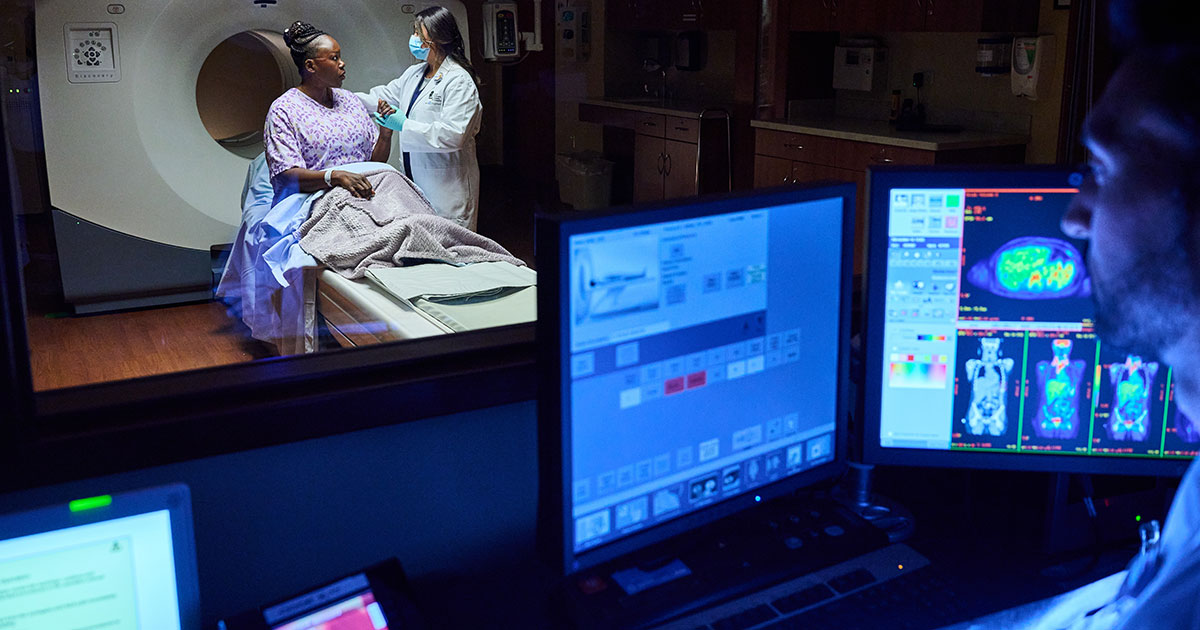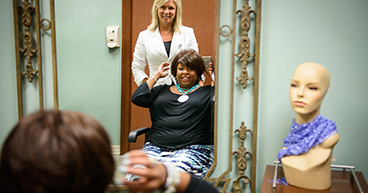
Everybody gets anxious—often by the littlest things. Maybe it’s from a minor misunderstanding with a relative or uncertainty about how to dress for a night out with a new friend. Worry, fear and consternation may also accompany serious matters such as financial problems or marital strife.
Anxiety typically comes and goes as causal situations arise or are resolved. But for cancer patients, this uneasiness is often a way of life that sets in the minute they’re diagnosed. Anxiety is one of the most common behavioral side effects of cancer. According to the National Behavioral Health Network, about half of cancer survivors experience some level of anxiety, some to the degree that they may be diagnosed with post-traumatic stress disorder.
And for many patients, anxiety escalates around the time they’re due for diagnostic testing or post-treatment imaging tests or scans.
“A patient may think, ‘I'm done with treatment right now, but I have to go back for scans,’” says Alexandria Callahan, a Behavioral Health Therapist at City of Hope Chicago. “’And if the scans show that the cancer is back, that's going to change my entire world again.’”
In fact, that heightened level of anxiety even has its own name. It’s called “scanxiety,” describing the increased level of anxiousness patients feel …
- In the weeks or days before a scan is scheduled to diagnose cancer, monitor the progress of treatment or determine whether the cancer has recurred
- During a scan and in the hours immediately before and after
- In the days and weeks before learning the scan results
“It’s a real thing, no question,” says Anthony Perre, MD, New Patient Intake Physician at City of Hope Atlanta and a Hodgkin lymphoma survivor. “I’ve experienced it, and I'm usually a pretty calm person. Everything gets ratcheted up.”
What are the symptoms of scanxiety?
Anxiety, defined as an uneasy sense of fear or dread, may escalate into heightened feelings of panic or doom. Cancer patients may become overwhelmed by these emotions during their cancer journey and develop an anxiety disorder, which is a recurring or persistent feeling of anxiety.
Symptoms of anxiety disorders may include:
- Shortness of breath
- Increased heart rate
- Sweating
- Restlessness
- Muscle tightness
- Lightheaded, faint or dizzy feeling
- Nausea or trouble eating
- Moodiness
- Trouble sleeping
Anxiety may make coping with the stress of cancer more difficult. Stress causes the body to release hormones that may increase heart rate, blood pressure and blood sugar. While research has stopped short of saying stress can cause cancer, the National Cancer Institute suggests that “chronic stress may cause cancer to get worse and spread” in those already diagnosed with the disease.
The symptoms of scanxiety vary from person to person and during different times of the testing process.
“My mood, my ability to sleep and even my interaction with my family were affected,” Dr. Perre says. “And then, once the scan was done, unfortunately, in most cases, you have to wait a pretty substantial amount of time for the results. And it's that time period when your quality of life is really affected by the anxiety.”
Rev. Percy McCray, Jr., our National Director of Faith-Based Programs, says his scanxiety symptoms included losing sleep and becoming easily agitated, irritable and withdrawn.
“I wasn’t really conscious about it, but my wife noticed I was exhibiting anxiety,” says Rev. McCray, who was treated for colorectal cancer at our Chicago hospital. “I was a bit agitated or frustrated when I was talking with individuals on the phone or trying to conduct business. And that is not my normal kind of persona and reaction to circumstances.”
What’s the difference: Anxiety and scanxiety? “It's the timing,” Callahan says.
Scans are usually painless, but they’re not fun. No one wants to be in a cold room, wearing a flimsy hospital gown, awaiting an CT scan or PET scan or having to slide tightly into an MRI tube.
But scanxiety is usually heightened not just because of the procedures but by the results they may produce. And some patients require regular scans for years after their treatment ends.
“Some patients are anxious about everything,” Callahan says. “For others, it's the anxiety specific to getting those scans, and with most other things, they’re fine. It's the idea of getting the scan and what the results are going to be. It’s really more about the results.”

How can you manage scanxiety?
Anxiety may be reduced or controlled with medication. But “a pill isn't going to fix the underlying cause,” Callahan says. “And some patients don’t want to take another pill, especially if they’re on chemotherapy or another treatment. So, we try to work with them and then teach them the tools they need so they're regulating themselves.”
Dr. Perre says he turned to cognitive behavioral therapy (CBT), designed to help patients address their negative emotions and empower them to reduce their stress by choosing more positive thoughts.
“I met with a therapist once a week for three or four months,” he says. “She trained me to cope with the stress I was under during my scanxiety. We used methods like guided imagery and breathing exercises. Retraining my brain and how it handled stress helped to diminish the anxiety around the time of scans.”
Dr. Perre says he also turned to spirituality to help him through his difficult times.
“My children were in a faith-based school at the time of my diagnosis, and they and their classmates were very open about wanting to pray for me,” he says. “I felt like I derived a lot of strength from the prayers given to me. That was a real thing. And I think it's based on my own faith. And, obviously, it's a very personal thing.”
For Rev. McCray, regular prayer and meditation are a way of life. During his scanxiety episodes, he also turned to physical exercise by taking long bike rides.
Other techniques that may be used to ease anxiety include those below.
Coping skills training: Coping skills help patients tolerate, reduce and deal with stressful situations. For example, a patient having difficulty concentrating and accomplishing tasks may work with a counselor to break down tasks into individual, small steps. This approach makes goals achievable and reduces stress.
Psychoeducation: This strategy combines elements of CBT, group therapy and education. The goal is to provide the patient with basic knowledge about various facets of depression and its treatment so he or she can work with a mental health professional for a better overall outcome.
“Practice self-care tools when you don't need them, especially those breathing exercises,” Callahan says. “Then, when you start noticing that shift in anxiety, you can more easily go into your exercise.”
If you’d like to learn more about the behavioral health services we offer for cancer patients, or if you’re interested in getting a second opinion on your cancer diagnosis and treatment plan, or chat online with a member of our team.


